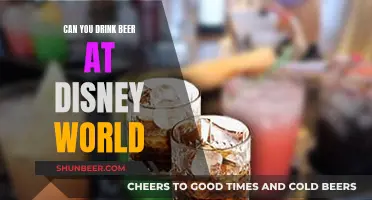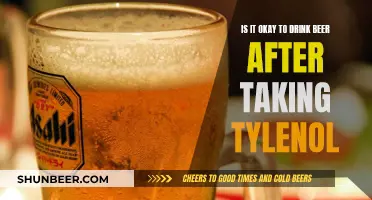
Whether or not teenagers should be allowed to drink beer is a contentious issue. While some parents believe that it is safer to introduce alcohol to their teens under supervision, health researchers are advocating for clear and consistent age limits on non-alcoholic beers, wines, and liquors. Alcohol is one of the leading causes of death and illness in young people, and studies have shown that not providing adolescents with alcohol is the best way to prevent binge drinking and alcohol-related harm. However, in reality, many teens will experiment with alcohol, and some parents feel pressured to supply it to their children if other parents are doing the same.
What You'll Learn
- Non-alcoholic beer is still regulated by the Federal Alcohol Administration Act
- Most states don't have age limits for buying non-alcoholic beer
- Researchers argue non-alcoholic beer could be a gateway to drinking for teens
- Parents are one of the main sources of alcohol for teenagers
- Alcohol is a major contributor to death and illness in young people

Non-alcoholic beer is still regulated by the Federal Alcohol Administration Act
In the United States, the legal drinking age is 21 years old. However, the laws surrounding the purchase and consumption of non-alcoholic beverages by minors are less clear. Non-alcoholic beer, defined as containing less than 0.5% alcohol by volume (ABV), is becoming increasingly popular. Despite its low ABV, non-alcoholic beer is still regulated by the Federal Alcohol Administration Act (FAAA) because it is considered a "malt beverage". The FAAA does not indicate an ABV minimum, creating a legal anomaly where non-alcoholic beer is subject to the same regulations as traditional beer.
The FAAA governs "malt beverages," which are defined as fermented beverages derived from an infusion or decoction in potable water of both malted barley and hops. Traditional non-alcoholic beer falls under the class type of malt beverages called "cereal beverages," which contain less than 0.5% ABV. To be subject to the FAAA, a non-alcoholic beer must first be considered a "malt beverage," so any malt beverage not made with hops would not be regulated by the FAAA.
The FAAA sets out rules for the labelling of non-alcoholic beer, which must include the producer, type, and volume. Labels must also include the phrase "Nontaxable under section 5051 I.R.C." and "contains less than 0.5% alc by vol." Additionally, the Government Health Warning is only required on products containing more than 0.5% ABV.
While the FAAA regulates non-alcoholic beer at the federal level, state laws also come into play. Some states, like Oregon, West Virginia, and Wyoming, prohibit the purchase of non-alcoholic beer by minors. Other states, like Alabama, allow non-alcoholic beer sales in wet counties but prohibit them in dry counties. A few states, such as Arizona, Georgia, Idaho, New York, and Tennessee, do not have a minimum ABV threshold for malt beverages subject to state laws.
The regulations surrounding non-alcoholic beer are complex and vary from state to state. While non-alcoholic beer is generally considered to be below the legal limit for alcoholic beverages, its classification as a "malt beverage" under the FAAA means that it is still subject to certain alcohol-related regulations. This highlights the need for clear and consistent age limits for non-alcoholic beverages, as advocated by some health researchers.
Misoprostol and Beer: A Safe Mix?
You may want to see also

Most states don't have age limits for buying non-alcoholic beer
In the United States, purchasing and consuming alcoholic beverages, including beer, requires buyers to be at least 21 years old. However, the laws surrounding non-alcoholic beverages are less clear-cut. Non-alcoholic beer (NA beer) typically contains less than 0.5% alcohol by volume (ABV), which is significantly lower than the 4-6% ABV found in traditional beer. Despite the low alcohol content, NA beers are still regulated by the Federal Alcohol Administration Act, and the laws vary from state to state.
In most states, there are currently no age limits for buying NA beers, which has sparked debate among health researchers. Some researchers argue that these beverages could serve as a gateway to drinking for minors and call for clear and consistent age restrictions. They liken NA beers to candy cigarettes and express concern that the similarities in taste, smell, and cultural experience to their alcoholic counterparts might increase the likelihood of minors transitioning to alcoholic beverages.
However, proponents of NA beers argue that they provide a valuable alternative for adults who want to cut back on alcohol consumption and its associated negative health effects. They emphasize the lack of evidence directly linking NA beverages to increased alcohol consumption among minors. Additionally, they believe that self-regulation within the industry is sufficient to address any potential concerns.
While the majority of states do not have age restrictions on NA beers, there are exceptions. For instance, in Ohio, individuals must be over 18 to purchase NA beers, while states like Oregon, West Virginia, and Wyoming restrict the purchase of NA beers with 0.5% ABV or higher to those 21 and older. Other states, like Alabama, have varying regulations depending on the county, with "sale" prohibited in dry counties. Given the complexity of these laws, most retailers choose to require customers to be at least 21 to avoid legal complications.
Drinking Beer While on Norvasc: What You Need to Know
You may want to see also

Researchers argue non-alcoholic beer could be a gateway to drinking for teens
In the United States, the legal drinking age is 21 years old. However, the laws surrounding the consumption and purchase of non-alcoholic beverages by minors are less clear. Non-alcoholic beer, for instance, typically contains less than 0.5% alcohol by volume (ABV), which is significantly lower than the 4-6% ABV of traditional beer. Due to this technicality, non-alcoholic beer can be purchased by minors in some states, including Alabama, Louisiana, Mississippi, and North Carolina. In other states, such as Oregon, West Virginia, and Wyoming, minors are prohibited from buying non-alcoholic beer.
The lack of consistent age restrictions on non-alcoholic beverages has sparked concern among some health researchers, who argue that these drinks could serve as a gateway to alcohol consumption for teenagers. They draw parallels with candy cigarettes and the recent rise in tobacco use among younger generations following a marketing push for vaping products. Researchers worry that non-alcoholic beverages, which often mimic the taste, smell, and branding of their alcoholic counterparts, may increase familiarity and normalize alcohol consumption for minors, potentially leading to a higher likelihood of purchasing alcoholic products in the future.
The Alcohol and Drug Foundation has joined the call for stricter regulations, suggesting that zero-alcohol beverages should be subject to the same laws as full-strength alcoholic drinks. They warn that these products could condition young people to drink alcohol in the long term. This concern is echoed by Dr. Amy Pennay, a senior research fellow at La Trobe University's Centre for Alcohol Policy Research, who advises that giving anything that might increase a young person's interest in alcohol is probably not a good idea. She emphasizes the importance of delaying the initiation of alcohol consumption, as those who start drinking at a later age are less likely to develop problematic drinking habits as they age.
However, others disagree with the need for government intervention. Marcos Salazar, head of the Adult Non-Alcoholic Beverage Association, acknowledges that while these drinks should not be marketed to children, he believes that the industry can self-regulate through targeted advertising and store placement. He argues that restricting access to non-alcoholic options could negatively impact adults who are trying to reduce their alcohol consumption for health reasons.
The debate highlights the complexities surrounding the regulation of non-alcoholic beverages and the potential impact on both adolescent drinking habits and adult consumers seeking alcohol alternatives.
Beer and Milkshakes: Mixing Drinks, Safe or Not?
You may want to see also

Parents are one of the main sources of alcohol for teenagers
Parents are an important influence on their children's attitudes and decisions around alcohol. While some parents do not condone underage drinking, others allow their children to drink on special occasions, such as family celebrations, during moments of instruction when they attempt to teach their teen about drinking, or to preserve family and cultural traditions. Research has shown that underage drinking is associated with a range of risks and negative consequences for adolescents, including alcohol poisoning, high-risk sexual behaviour, and accidental injury. Therefore, it is crucial for parents to understand the potential risks associated with providing alcohol to their children and to set clear rules and boundaries to prevent underage drinking and reduce the likelihood of alcohol-related harm.
Reasons for parental provision of alcohol
Parents may allow their teenagers to drink for various reasons, including deliberate, spontaneous, and harm reduction motives. Some parents believe that providing alcohol to their children can teach them to drink responsibly and appreciate alcohol in moderation. They may also want to preserve family and cultural traditions where drinking is considered acceptable, especially during special occasions. Additionally, some parents feel pressured by other adults or their spouse to let their teen drink, while others fear that forbidding underage drinking may harm their relationship with their child or lead to rebellious behaviour.
Impact of parental provision on adolescent alcohol use
Studies have found that parental provision of alcohol is generally associated with increased adolescent alcohol use and, in some cases, increased heavy episodic drinking and higher rates of alcohol-related problems. Allowing underage drinking at home or during family gatherings may provide a sense of control and supervision for parents. However, it is important to note that even small amounts of alcohol, such as sips or tastes, can increase the likelihood of early onset drinking, binge drinking, and alcohol-related harm among teenagers.
Strategies for prevention
To reduce underage drinking and minimise potential harm, parents should be aware of the risks associated with providing alcohol to minors. Clear and consistent rules about alcohol use, strict enforcement of drinking age limits, and open communication with teenagers about the dangers of alcohol are essential. Additionally, parents can model responsible drinking behaviours, such as refusing a drink, having alcohol-free days, and enjoying social occasions without alcohol as the focus. By setting a positive example and providing age-appropriate education, parents can help shape their children's attitudes and decisions around alcohol, ultimately supporting them to reach their full potential.
Breastfeeding and Beer: Is Half a Beer Safe?
You may want to see also

Alcohol is a major contributor to death and illness in young people
Alcohol is a toxic and psychoactive substance that can cause dependence, and early onset of substance use is associated with a higher risk of developing dependence and other problems during adulthood. Worldwide, more than a quarter of all people aged 15-19 are current drinkers, and the prevalence of heavy episodic drinking among this age group was 13.6% in 2016, with males most at risk. Alcohol use in adolescence is associated with neurocognitive alterations, which can lead to behavioural, emotional, social, and academic problems later in life.
In addition to the direct health risks, alcohol consumption can also cause significant harm to others. Alcohol-related road crashes result in thousands of deaths each year, and many of these are caused by someone else's drinking. Alcohol-impaired driving increases the risk of accidents, and young people are already more vulnerable to road traffic injuries as inexperienced road users. Alcohol-related crashes not only affect the driver but also passengers, pedestrians, cyclists, and other road users.
Furthermore, alcohol can contribute to interpersonal violence, which is a leading cause of death among adolescents and young people globally. Alcohol intoxication can increase the risk of violent behaviour and alter judgement, leading to aggressive actions with deadly consequences. Alcohol is also linked to a higher risk of self-harm and suicide, which is a leading cause of death among people aged 15-19 years.
To reduce the harmful effects of alcohol, effective control interventions, public health policies, and educational initiatives are necessary. It is important for young people to be aware of the risks associated with alcohol consumption and to make informed choices to protect themselves from its potential dangers.
Beer and Zyrtec: Is It Safe to Mix?
You may want to see also
Frequently asked questions
Ideally, no. Alcohol is one of the biggest contributors to death and illness in young people. However, in some states in the US, minors can consume alcoholic beverages under the supervision of a parent, guardian, or spouse who is over the age of 21.
Non-alcoholic beer is a brew that contains less than 0.5% alcohol by volume (ABV). While it is technically classified as an alcoholic beverage, many common food products that we consume daily have a similar or higher ABV.
The answer depends on the relevant state laws and retailer policies. While most states don't have age limits for buying non-alcoholic beer, some researchers argue that they could be a gateway to drinking for teenagers and are calling for clear and consistent age limits.







